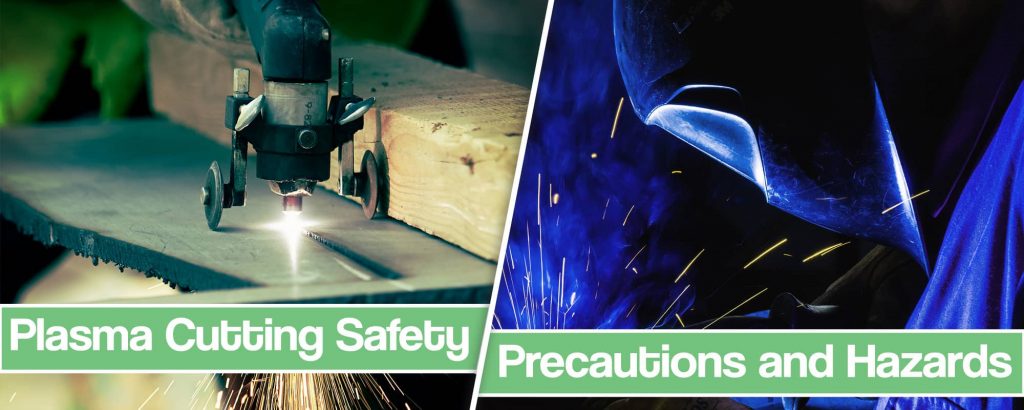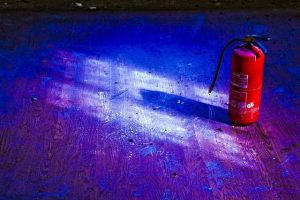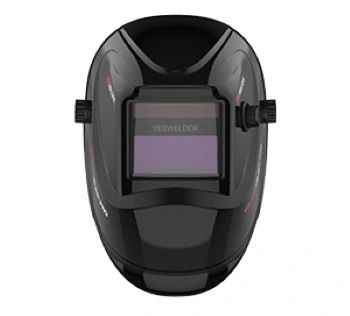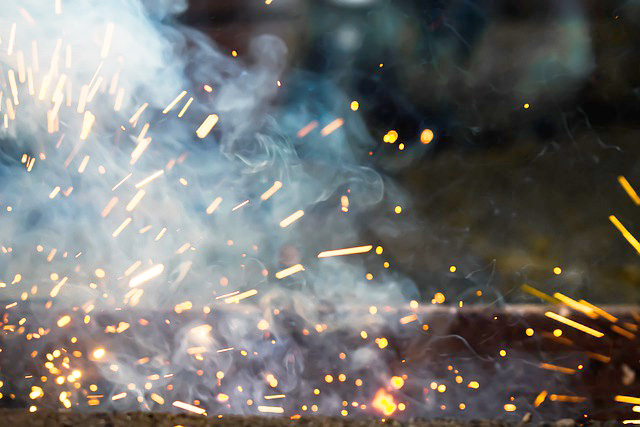Just because the plasma cutting process is more straightforward and easier to perform than any welding process doesn’t make it much safer.
A plasma cutter outputs up to ten times more voltage than an inverter welding machine.

This voltage could seriously injure you or even lead to death. But that’s just one of the safety aspects that you must consider. This article will teach you safety precautions for plasma arc cutting and what personal protective equipment you will need.
Why the plasma cutting process is dangerous
To understand the dangers associated with plasma cutting arc, you should understand the basics of how the process works.
Here is a quick rundown for you:
The plasma cutter works by conveying an electric arc through the compressed air or a compressed gases through a constricted opening of the nozzle on the cutting torch.
The compressed gas or air becomes ionized in the process and becomes conductive which causes it to heat up to the point of becoming the fourth state of matter or otherwise known as plasma.
A plasma cutter outputs a lot more voltage than a welder. Typically somewhere in a range of 100-400V. Due to the nature of the plasma arc, the voltage needed to start and maintain the pilot arc is really high. Here is a short but excellent video from Hypertherm explaining exactly what happens in the torch:
Applying the arc to the metal will cut through it with ease. However, the plasma cutters can only work with the conductive metals because the arc needs to jump from the electrode in the torch to the metal piece.
So as you see plasma cutting is dangerous because:
- The voltage is really high and the circuit needs to be closed. Machine – torch – metal – ground.
- The torch outputs a lot of heat and there is sparks and molten metal drops from metal cutting
- Metal being cut will output dangerous fumes
- Arc has an intense light that can lead to eye injury and permanent blindness if constantly exposed. In addition, the UV radiation is tremendous and you need proper equipment to stay safe.
The safety precautions and prevention of the plasma cutting hazards
Now let’s see some practical tips and plasma cutting safety measures you can take to make your work safe and productive.
Generally speaking, you should have substantial safety measures in place in your welding area. This article is mainly aimed at hobbyists or smaller welding shop owners, but even if you are not working on an industrial scale, you must have a solid safety plan when working with metal.
Here is a short video by Lincoln Electric to help you visualise the safety aspects. But we went way more in detail in the article below.
The safety precautions explained below should be looked at as an addition to your metalwork safety because you are obviously interested in adding the plasma cutter or a CNC plasma machine to your operations or improving that aspect of your safety.
Avoiding Electrocution
Thanks to the high voltages the plasma cutters utilize you should pay extra attention to avoiding electrocution.
Touching live electrical parts will result in severe burns or fatal shocks leading to death. Thankfully plasma arc cutting torches are usually designed with special safety interlock systems that turn off the machine if the shield cup is loose or if the tip touches the electrode inside the nozzle.
Still, there are other areas where you must pay close attention to.
If any of the cables got damaged and the bare wire got exposed or any connectors are loose, you shouldn’t use the cutter until everything is fixed. This should be examined every day before starting your work as a daily safety checklist.
When operating a plasma cutter you must stand on the nonconductive ground such as a dry rubber mat or plywood. The downside is that materials like this can catch fire so you must consider that. Also, avoid standing on a wet surface when working with a plasma cutter.
Water is a great conductor and the plasma cutter uses very high voltages. Not a very good mix. You must wear dry clothes and especially gloves. The entire area where you work must be dry. Even the body perspiration can increase the chances of an electric shock so make sure you are not sweating.
According to the National Electrical Code (NFPA 70) and OSHA standards, your plasma cutting equipment should be properly grounded. That’s the safest way of conducting electricity through the metal piece and avoiding electric shock.
Ground your workpiece to proper earth ground and connect the frames of all electrically powered machines to the suitable ground. Before starting your work, you should double check if everything is grounded properly.
Fire prevention
Preventing fire should be one of the most important things on your safety checklist. Never start your work if there are any unresolved fire hazards.
Plasma cutting produces immense heat and causes sparks and molted metal drops to fly off the metal being worked on.
The metal becomes incredibly hot as well and especially in the area near the cutting line.

Depending on the thermal conductivity of the metal, the outer edges of the metal may also heat up severely.
You should cut metal only in a well secure area without any other materials or equipment that can catch fire. Move everything else at least 35ft from the work area or use protective flame-proof covers.
Never use a plasma cutter in the vicinity of the pressurized gas, flammable liquids, vapors or dust. Keep a properly maintained fire extinguisher at hand in case the fire does break out.
Plasma eye protection
When plasma arc cutting you need to protect your eyes from both flying debris and electromagnetic radiation.
Flying sparks and debris are self-explanatory. You need some sort of eye protection. Safety glasses or face shields will do the trick but what about UV radiation? Isn’t a plasma cutter less dangerous than a welder in this manner?
Well yes but no. It depends on the amperage you are working with.
Plasma cutting is generally speaking a bit less UV intensive than welding but that doesn’t mean that you shouldn’t use a welding helmet.

The minimum shade protection you need to use with a plasma cutter is shade 4 when working with less than 20 amps of cutting arc power. You will often be working in a range of 30 to 50 amps so it is best to use a proper welding helmet. The helmet will provide additional protection for your face and neck which is a bonus. You don’t want those areas exposed to infrared and UV light.
If you are not using more than 20 amps to cut, you can get by with safety glasses with a shade level of 4 or 5 but your face will not be protected unless you use a face shield.
Also, don’t forget to use a side shield if someone else is making welds or cuts in your cutting area to reduce the risk of arc flashes.
Toxic fumes hazard
Plasma arc cutting creates fumes and gases just like welding does. These fumes present a major hazard and must not be inhaled. Proper ventilation is required or usage of respirators and fume extraction systems.
When using a plasma cutter in a confined space you need to use a welding respirator and have a proper ventilation system in place. If the airflow is limited use a welding fume extractor. It is necessary to abide by the codes and standards in your area.

OSHA and ANSI standards should always be followed. Depending on the workload you do you may need a fume extracting system regardless of the natural airflow.
Additionally, if you are plasma arc cutting any coated metals like galvanized steel, cadmium-plated steel, lead and others you must use a quality respirator rated for the toxic fumes you are exposed to. You will also need a fume extraction system, especially if other people are in the working area.
Always remove the coating on such metals as much as possible before plasma cutting. This will significantly reduce the toxicity of the fumes.
Get yourself a quality plasma cutter
Working with inadequate plasma cutters can definitely lead to some safety hazards. Let’s say you are using a hobbyist grade unit to cut professionally every day. First of all the machine won’t last very long but what’s worse it could become a hazard.
Your equipment needs to be rated for the work you are doing. A harsh environment with a lot of usage on a daily basis will require a more durable unit with more durable wiring, leads, torch and etc.
You can read our choices for the quality plasma cutters on the market and decide which one is good enough for your use case scenario. Or if you already have a unit of your own, compare it with our reviews and see where it falls quality-wise.
Personal Protective Equipment (PPE) For Plasma Cutting
We already discussed some PPE while explaining the prevention of the hazards above but to further improve your understanding of plasma cutting safety let’s discuss the PPE in more detail.
- Hands: You should wear leather welding gloves rated for MIG or Stick work because while plasma cutting you will experience a similar exposure to molten metal and sparks. Don’t wear thin stuff such as TIG-rated ones unless you are working with thin metal and using a low amperage. It is also good to wear rubber gloves underneath your leather gloves to improve the electrocution resistance.
- Welding helmet, face and eye protection: Auto darkening helmet will serve you best but you can also use a passive hood or welding goggles. Just make sure that the DIN rating is sufficient for the amperage you will be cutting with. A good rule of thumb is less than 20 amps DIN4, about 20-40 amps DIN 5, 40-60 amps DIN6 and so on. If you wear welding goggles make sure you also wear a face shield as protection against flying debris and sparks.
- Boots: When doing any plasma cutting you will need high top leather shoes insulated against electricity, slip resistant, puncture resistant and have a met guard to protect the front area against molten metal and sparks. While you won’t be slipping and doing anything extreme it is a standard to wear proper boots when working with metal. What if you step on a sharp piece of metal? What if you accidentally step on a live wire somehow or in a moisture rich area that somehow conducts electricity?
- Protective clothing: Flame resistant clothing is necessary for your torso area. If you are working with low amps you can use 100% cotton jacket because it breathes well. But if you are using high amp arc current it is a good idea to use a jacket that combines leather and cotton to have increased protection and not collect any additional moisture underneath it. Avoid anything that contains synthetics because they melt easily. The proper clothing for this kind of work is free from crevices, cuts or anything that can catch a piece of hot slag and other debris.
Conclusion
As you see, the protection needed for plasma arc cutting is similar to weld protection.
Where it differs the most is the emphasis on electrocution and fire hazards. The immense heat released under pressure and with extreme voltages of plasma arc is what makes all the difference.
Protect yourself well and always follow a proper safety protocol. Routinely inspect for any poor connections, proper grounding, if your fume extractors are working well and the condition of your personal protective equipment and you will be much safer. Ensure that other workers are not put in harm’s way and that they are not distracting you with noise or anything else. When you are working be focused and don’t let anything sidetrack you.
Resources:
- Plasma cutting: Control of fume, gases and noise at hse.gov.uk
- Plamsa Arc Cutter Safety at www.alce.vt.edu
- Plasma Arc Cutting Hazards at ohsonline.com
- Safety information document at torchmate.com




